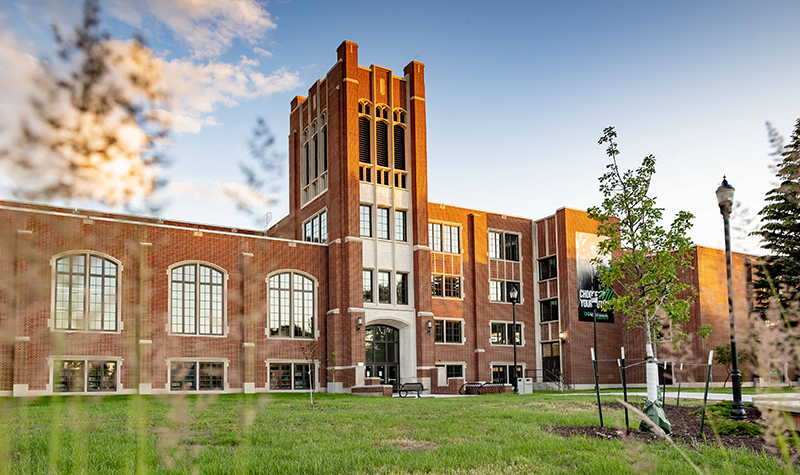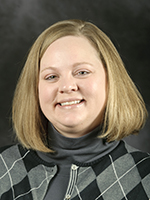More than a headcount: Accreditation self-study is under way
As UND makes its case for reaccreditation, leaders of the effort call across campus for fact-finding assistance

Every 10 years, local and state governments across America erupt in a frenzy of activity, as they prep for a critical event: the Census.
The population count affects so many aspects of civic life that it deserves all the attention it can get, the governments know.
Similarly in academia, faculty and staff expect a flurry of documents, emails and meetings every 10 years, as their institution undertakes a vital pursuit of its own: reaffirmation of accreditation.
At UND, that time has arrived.
From now until November of next year, six teams of UND faculty and staff will be hard at work compiling sources and procuring evidence in order to produce the University’s most important self-study.
Besides being a massive undertaking that comes around every 10 years, UND’s “Assurance Argument” for reaffirmed accreditation resembles the Census in one other respect: both involve a headcount. But the Argument actually will do the Census one better, because the Argument also will take into account just about everything happening at the institution.
And with that and accreditation’s importance in mind, UND leaders are calling on the campus community to cooperate fully and enthusiastically with the fact-finding process that’s already underway.
By June 2023, the University plans to have this report finalized and submitted to its accreditor: the Higher Learning Commission (HLC). Since 1913, UND has been recognized by the U.S. Department of Education by way of this accrediting organization.
Every 10 years, the HLC requires a reaffirmation of UND’s legitimacy as an academic institution.

According to leaders of the effort, the lengthy and detailed process is not only a chance to earn a “stamp of approval” from regulators, but also to highlight what UND has done well in the past decade. And through the data-finding process, there is also the chance to use that information to improve.
“Improvement” is the word of choice for Tim Burrows, the director of university assessment and accreditation who also serves on UND’s executive committee for reaccreditation.
“In order to provide a quality education for our future generations of learners, we have to make sure we’re doing the best we can,” Burrows said. “And part of that is being honest with ourselves and the public. This process allows us to identify the areas where we’re doing very well, but the best part of it is saying, ‘We can do better here.’ This is our time to shine.”
President Armacost furthered that notion in remarks to UND Today, saying, “I am proud of the work happening across the entire campus as part of the HLC reaffirmation process. This is an important evaluation of our university that will help showcase the great things happening at UND and provide learning opportunities for our growth as a campus.”
Comprehensive evaluation across campus
The HLC breaks down the assurance argument into five criteria, as well as a sixth section regarding federal compliance with U.S. Department of Education rules. The main criteria are:
- Adherence to mission
- Ethical and responsible conduct
- Resources and support for teaching and learning
- Evaluation and improvement of teaching and learning
- Resources, planning and institutional effectiveness
As fall turns to winter, each of the six writing teams will be searching across the institution for evidence tied to their respective point, all of which are further broken down into subcategories.
Once the teams are ready to fully substantiate their findings, the actual writing can begin. In total, the full report cannot exceed 35,000 words, or about 90 pages of single-spaced type.
UND has created its own webpage about the reaffirmation process. It provides information about accreditation, the timeline of the work and a breakdown of the numerous committees and teams dedicated to the process. In total, 33 full-time faculty and staff make up the volunteer writing teams.

But as executive committee member and Professor Deborah Worley knows, the decade-long cycle isn’t really one that comes to a close. Following her experience as a writing team member for the 2014 reaffirmation, she co-lead the 2018 writing effort that serves as an interim check-in with the HLC. Then, in 2019, Worley successfully applied to join the HLC as a peer reviewer, meaning she is among the teams conducting campus visits for other institutions seeking HLC accreditation.
“It’s not just every 10 years they check in with us to see how we’re doing,” said Worley, a professor of education, health and behavior. “We’re constantly providing them with data, but the comprehensive evaluation we’re currently working on is incredibly important.
“My research at UND is tied with assessments and focuses on cycles of continuous improvement in education – how we should be looking for ways to not just collect data on how we’re doing with teaching and learning, but how we can use that data to improve. And it’s the same concept at a course level as it is at a program level and the institutional level.”
Input is welcome and needed
Alongside Worley and Burrows on the executive committee are Scott Correll, UND registrar, and Ryan Zerr, associate dean for curriculum at the College of Arts & Sciences and professor of mathematics.
Worley said one of their duties as executives is to be a resource for the writing teams, to point them in the right direction for information and to help them understand the expectations laid out in the criteria. As UND’s liaison to the HLC, Burrows is especially knowledgeable about what the accreditor is looking for.
“And what HLC is ultimately looking for is, first, do we do what we say we are doing? And, second, do we have policies in place that we are following?” Burrows said.
To make an example of the first criterion, which is adherence to the stated mission of the University, the Criterion One team will be looking at – and eventually writing about – all of the evidence that shows the mission’s effect on University conduct, Burrows said.
“It’s everything that ranges from what we post on our website, through our student, faculty and staff handbooks, our various rules, protocols and policies, even how the State Board of Higher Education rules down,” Burrows said. “With teaching and learning, evidence ranges from workshops that TTaDA is hosting to how many students are using the Wellness Center and how they rate the quality.
“All of the data goes into painting the full picture of accountability.”
In a year, the resulting product will look much like that of a published research paper. It’s rare to see statements not immediately followed by citations. Both Worley and Burrows stress how thorough the Assurance Argument is meant to be, as it touches all aspects of UND.
From the criterion writing teams, the draft will go to the executive team for further editing and formatting into one document, which will then go to University administration and eventually submission to the HLC. The HLC’s deadline is June 2023 for the final submission.
“It’s important for people to know that the data we’re collecting and reporting will involve everyone on campus,” Worley said. “Given the scope, we welcome and in fact need input from people in all parts of the institution. This is the opportunity for people to tell UND’s story from the past number of years, and everything that’s changed in that time.”



